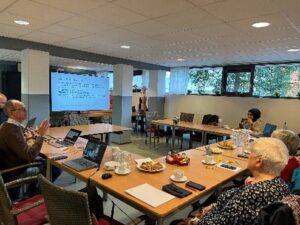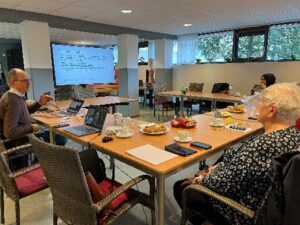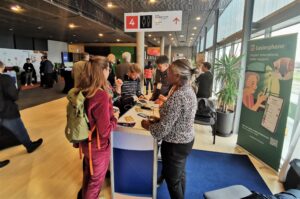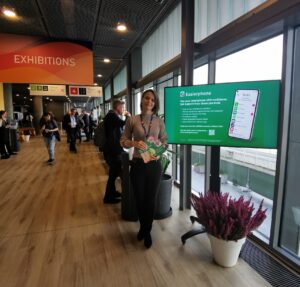Easierphone's Multilingual YouTube Channel: A Global Approach to Tech Simplification
In an era defined by technological advancements, a simple solution has emerged to bridge the gap between seniors and smartphones – the Easierphone app. With the launch of its website and YouTube channel, Easierphone is taking its commitment to accessibility and user-friendliness to the next level by promoting the app through informative videos available in five languages: English, Polish, German, Turkish, French, and Dutch.

A Multilingual Mission
The Easierphone YouTube channel and the Easierphone website serve as hubs for seniors around the world seeking to embrace technology with confidence. By providing instructional content in six prominent languages, Easierphone ensures that its message of simplification transcends language barriers and reaches individuals across diverse cultural backgrounds.
Informed Empowerment in Five Languages
The website features comprehensive guides, each meticulously crafted to cater to users of varying linguistic preferences. The step-by-step instructional videos walk viewers through the installation process, customization options, and practical usage of the Easierphone app. With a focus on enhancing the user experience, these guides empower seniors to effortlessly navigate their smartphones, connect with loved ones, and explore the digital realm with newfound ease.
Addressing Global Needs
Understanding that technological challenges are universal, Easierphone's multilingual approach reinforces its dedication to fostering a more inclusive digital landscape. By providing content in English, Polish, German, Turkish, Dutch, and French, the channels acknowledge the diverse needs of seniors worldwide, ensuring that no one is left behind in the wake of digital evolution.

Engaging in the Language of Inclusion
Easierphone's YouTube channel and the website are more than just a platform for promoting an app; it's a beacon of inclusion and empowerment. By catering to a wide array of linguistic preferences, these channels encapsulate the brand's mission to simplify technology for all. Whether it's a senior in Poland, a grandparent in Germany, or a retiree in the Netherlands, the Easierphone channels stand as a testament to the power of accessible, multilingual communication.
A Promising Journey Ahead
As Easierphone continues its journey to make technology more intuitive for seniors, its multilingual website and YouTube channel become a pivotal vehicle for change. By delivering content in languages that resonate with seniors worldwide, the channel enables users to confidently embark on their digital journeys, fostering connections and experiences that transcend linguistic boundaries. With each video, Easierphone invites seniors to embrace the opportunities of the digital age, reminding them that it's never too late to embark on a path of exploration and discovery.
Empowering Caregivers in Care Homes with Easierphone: A Game-Changer in Elderly Care
Care homes play a vital role in providing comprehensive care and support to elderly residents who require assistance with daily activities. Formal caregivers in care homes often face the challenging task of meeting diverse resident needs efficiently and ensuring their safety and well-being. In this blog post, we will explore how Easierphone, a specialized mobile device, can be a game-changer for formal caregivers in care homes, making their jobs more manageable and improving the overall quality of care.
 Understanding the Role of Caregivers in Care Homes
Understanding the Role of Caregivers in Care Homes
Formal caregivers in care homes are dedicated professionals responsible for providing a wide range of services to elderly residents. These services include assistance with personal hygiene, medication management, mobility support, meal preparation, and emotional support. Caregivers also play a crucial role in monitoring residents' health, identifying any changes or emergencies, and facilitating communication between residents and their families.
The Challenges Faced by Caregivers
- Time Management: Caregivers often have a limited amount of time to attend to each resident's needs. Balancing multiple tasks and ensuring that each resident receives adequate attention can be incredibly challenging.
- Communication: Effective communication is key to providing high-quality care. Caregivers must stay in touch with residents, their families, and other healthcare professionals involved in their care.
- Medication Management: Accurate administration of medications is essential, and errors can have serious consequences. Caregivers must ensure residents receive the right medications at the right times.
- Monitoring: Regular monitoring of residents' health is essential for early detection of health issues or emergencies, but it can be time-consuming and resource-intensive.
How Easierphone Can Support Caregivers
Easierphone is a purpose-built mobile device designed with caregivers in mind. Here's how it can address the challenges faced by formal caregivers in care homes:
- Streamlined Communication: Easierphone Assistant App offers a simple and intuitive interface for easy communication. Caregivers can use it to set the alarm whenever there is a need to take medications or visit a doctor.
- Emergency Button: Easierphone App can be used to alarm the caregiver when an emergency situation occurs with a single click by sending detailed GPS position of an elderly. This feature reduces the risk of serious dangerous life-threatening incidents.
- Easierphone Activity Trends: Easierphone is equipped with a monitoring feature. Caregivers can access real-time data about residents' activity levels, enabling them to respond promptly to disturbing changes in their daily activity.
- User-Friendly Interface: Easierphone is designed to be user-friendly, making it accessible for both caregivers and elderly residents. Its simplicity ensures that caregivers can focus on providing care rather than dealing with complex technology.
Easierphone is a valuable tool that can significantly improve the lives of formal caregivers in care homes. By streamlining communication, simplifying medication management, enabling resident monitoring, and enhancing task management, it empowers caregivers to provide higher-quality care to elderly residents. As the demand for elderly care services continues to grow, solutions like Easierphone play a crucial role in enhancing the efficiency and effectiveness of care delivery, ultimately improving the well-being of elderly residents and the satisfaction of their caregivers.
Navigating Depression Among Seniors in Modern Times
As the sun sets in the golden years, a hidden struggle often emerges within the aging population – depression. Far from being a normal part of growing older, depression among seniors demands our attention and understanding. In this article, we delve into the complexities of depression among seniors in the modern age, shedding light on its prevalence, causes, challenges, and crucial strategies for support.

The Hidden Epidemic
Depression is not a condition confined to any specific age group, and seniors are no exception. In fact, the World Health Organization states that approximately 7% of adults over the age of 60 globally suffer from depression. However, this statistic only scratches the surface, as depression often goes unnoticed or is dismissed as a natural part of aging.
Unmasking the Causes
Several factors contribute to depression among seniors in the contemporary world. The loss of loved ones, retirement, health issues, and a sense of isolation due to changing social dynamics can lead to feelings of sadness and despair. Moreover, the digital age has brought its own set of challenges, as seniors struggle to adapt to rapid technological advancements, potentially exacerbating feelings of isolation.
Challenges and Misdiagnoses
Identifying depression among seniors can be particularly challenging. Symptoms might be attributed to physical ailments or dismissed as a consequence of age-related changes. This tendency to misinterpret depression as a normal part of aging can delay proper diagnosis and treatment, further deteriorating the individual's mental health.

Breaking the Silence: Strategies for Support
- Raising Awareness: Dispelling the notion that depression is a "natural" aspect of aging is the first step. Raising awareness among seniors, caregivers, and healthcare professionals can encourage early intervention.
- Integrated Healthcare: Holistic healthcare that addresses both physical and mental well-being is essential. Ensuring that healthcare professionals consider mental health as a crucial aspect of overall health can lead to better diagnosis and treatment.
- Community Engagement: Combatting isolation is pivotal. Creating and maintaining community spaces, clubs, and support groups can offer seniors a sense of belonging and purpose.
- Family and Caregiver Education: Equipping family members and caregivers with the knowledge to identify signs of depression can lead to timely interventions.
- Access to Mental Health Services: Ensuring easy access to mental health professionals who are trained to address the unique needs of seniors can make a significant difference in treatment outcomes.
- Technological Inclusion: Seniors can benefit from learning and utilizing technology to stay connected with loved ones, access information, and engage in virtual social activities.
The Call for Compassion and Understanding
Depression among seniors in the modern era necessitates a collective effort to foster a culture of compassion and understanding. By dispelling the myths surrounding depression and recognizing the signs, we can offer seniors the support they deserve. As society marches forward, let's ensure that our seniors aren't left in the shadows, but rather embraced with open arms, enabling them to live their later years with the mental well-being they deserve.
Eyes on the Prize: Tips to Improve Seniors' Vision
Good vision is a precious gift that allows us to appreciate the beauty of the world and maintain our independence. As we age, it's not uncommon for our eyesight to change, but there are proactive steps seniors can take to improve and preserve their vision. In this blog post, we'll explore practical tips to help seniors maintain and enhance their sight, ensuring they continue to see the world clearly and vibrantly.

- Regular Eye Exams
Routine eye examinations are essential for seniors. These exams can detect early signs of eye diseases like cataracts, glaucoma, macular degeneration, and diabetic retinopathy. Early diagnosis and treatment are crucial for preserving vision.
- Maintain a Healthy Diet
A balanced diet rich in vitamins and minerals is essential for eye health. Foods like leafy greens, carrots, sweet potatoes, and fish high in omega-3 fatty acids can support optimal eye function. Nutritional supplements, as recommended by a healthcare professional, can also be beneficial.
- Stay Hydrated
Proper hydration is vital for overall health, including eye health. Dehydration can cause dry eyes, which can be uncomfortable and impact vision. Seniors should aim to drink an adequate amount of water daily.
- Protect Your Eyes from UV Rays
Prolonged exposure to UV rays can contribute to eye problems, including cataracts and macular degeneration. Seniors should wear sunglasses with UV protection when outdoors, even on cloudy days.
- Quit Smoking
Smoking is a major risk factor for eye diseases such as macular degeneration and cataracts. Quitting smoking can significantly reduce the risk of developing these conditions and improve overall health.
- Manage Chronic Health Conditions
Seniors with chronic health conditions like diabetes should closely manage their conditions to prevent diabetic retinopathy, a leading cause of blindness. Regular check-ups and blood sugar control are crucial.
- Use Proper Lighting
Good lighting is essential for seniors to see clearly. Adequate lighting can reduce eye strain and make reading, cooking, and other tasks easier. Consider installing task lighting in specific areas, such as over kitchen counters and reading nooks.
- Monitor Medications
Certain medications can have side effects that affect vision. Seniors should discuss their medications with their healthcare provider to ensure they are not adversely impacting their eyesight.
- Stay Physically Active
Regular physical activity can improve circulation, which is essential for eye health. Engage in low-impact exercises like walking or swimming to maintain overall well-being.
- Eye Exercises
Simple eye exercises can help maintain flexibility and focus. Practice activities like rolling your eyes, focusing on a distant object for a few seconds, and then refocusing on a nearby object. These exercises can reduce eye strain.
- Adequate Rest
Getting enough sleep is crucial for overall health, including eye health. Adequate rest allows the eyes to recover and prevents eye fatigue.
- Reduce Screen Time
Extended screen time, whether on computers, tablets, or smartphones, can lead to digital eye strain. Seniors should take regular breaks, adjust screen brightness, and use screen filters to reduce strain.
Sight is a precious sense that greatly enhances our quality of life. Seniors can take proactive steps to maintain and improve their vision, from regular eye exams and a healthy diet to protecting their eyes from UV rays and managing chronic health conditions. By incorporating these tips into their daily routines, seniors can continue to enjoy clear and vibrant vision well into their golden years. Remember, it's never too late to prioritize eye health!
Unconventional (and Hilarious) Brain Exercises for Seniors
Who says brain exercises have to be dull and dreary? Certainly not us! When it comes to keeping our minds sharp, the options are as diverse as the colors in a crayon box. So, if you're an elderly person looking to boost your brainpower or you're caring for a senior who needs a mental pick-me-up, here's a list of unconventional brain exercises that are not only effective but also a whole lot of fun!

- Bingo Brain Busters
Bingo is not just for retirement communities. Turn this classic game into a brain workout by challenging yourself or your elderly loved one to play multiple cards simultaneously. Keeping track of all those numbers will surely keep those synapses firing!
- Simon Says: The Memory Edition
Remember the good ol' Simon Says game from your childhood? Well, this is its more mature sibling. Play a few rounds with a twist: the commands become longer and more complex. "Simon says, touch your nose, hop on one foot, and recite your favorite knock-knock joke!" It's a hilarious way to test and improve memory.
- Sudoku Smackdown
Sudoku is a beloved brain-boosting game, but let's kick it up a notch. Get a giant Sudoku puzzle and some comically oversized pencils. Solving those numbers will feel like you're cracking the Da Vinci Code!
- Comedy Club Crunch
Laughter is the best medicine, and it's also a fantastic brain exercise! Attend a local comedy show or watch some stand-up specials. The brain gets a workout deciphering punchlines, and laughter releases endorphins that boost mood and cognitive function.
- Cooking Capers
Cooking can be both a sensory and intellectual adventure. Try out new recipes, experiment with unfamiliar ingredients, or even engage in a friendly family "Chopped" competition. Just be sure to have the fire extinguisher handy!
- Karaoke Cabaret
Belting out your favorite tunes is a surefire way to stimulate brain activity. Plus, it's an excellent stress-reliever. Gather friends and family for a karaoke night that rivals any reality singing competition.
- "Name That Tune" Trivia
Challenge your musical memory by playing a "Name That Tune" game. Put on snippets of songs and see who can guess the title and artist first. Bonus points for the most embarrassing dance moves!
- Puzzling Paintings
Take up painting or try your hand at adult coloring books. Creating art engages various parts of the brain and can be incredibly therapeutic. Plus, you'll end up with some fascinating artwork for your walls.
- Wordplay Wonderland
Become a wordsmith with crossword puzzles or word search games. And for an added twist, challenge a fellow brainiac to a Scrabble showdown. The bigger the words, the bigger the laughs!
- Animal Antics
Visit a local zoo or aquarium and embrace the joy of observing animals in their element. Learn about their behaviors, habitats, and unique features. It's like a zoology class, but with more adorable creatures.
Brain exercises don't have to be mundane; they can be an absolute hoot! By infusing humor and creativity into these unconventional brain workouts, you'll keep those mental gears turning while having a blast. So, grab a giant Sudoku puzzle, prep your karaoke playlist, and let the brain games begin. Who knew that boosting cognitive function could be this side-splittingly fun?
Ensuring Seniors' Dignity and Rights in Today's Society
As society continues to evolve and transform, it is imperative that we uphold the rights and dignity of our senior citizens. In an era marked by progress and technological advancements, the well-being and autonomy of older adults remain paramount. Today, the focus on seniors' rights has never been more critical, as we strive to create a more inclusive and equitable society for all.

An Aging Society: The Importance of Seniors' Rights
The world is witnessing a demographic shift towards an aging population. Longer life expectancies, coupled with declining birth rates, are resulting in a greater proportion of seniors within our communities. This shift underscores the need to address the specific challenges and rights of older individuals, ensuring they can enjoy a life of respect, independence, and fulfillment.
The Foundation of Rights
The rights of seniors are anchored in the principles of human dignity, equality, and non-discrimination. Today's seniors have lived through historical events, societal changes, and technological revolutions, contributing significantly to the development of the world we inhabit. As such, they are entitled to fundamental rights that encompass health, social participation, economic security, and protection against abuse and neglect.
Elder Abuse: A Modern Challenge
In the contemporary landscape, one concerning issue that demands immediate attention is elder abuse. Seniors are vulnerable to various forms of mistreatment, including physical, emotional, and financial abuse, as well as neglect. Recognizing this, governments, organizations, and communities are increasingly focusing on raising awareness about elder abuse prevention and providing support mechanisms for victims.
Promoting Active Aging
The concept of active aging has gained prominence in recent years. Active aging emphasizes the need to ensure that seniors are able to remain engaged, continue learning, participate in the workforce if they choose to, and contribute meaningfully to their communities. By creating environments that support active aging, societies can help seniors lead fulfilling lives while dispelling stereotypes associated with aging.
Technology and Access to Information
In the digital age, access to information and technology plays a vital role in seniors' lives. Ensuring digital literacy among older adults is crucial to their ability to stay connected, informed, and engaged. Efforts to bridge the digital divide are imperative, enabling seniors to access healthcare resources, communicate with loved ones, and participate in virtual communities.
A Holistic Approach: Healthcare and Social Services
Seniors' rights extend to healthcare and social services, encompassing access to quality medical care, mental health support, and social programs. Policies and initiatives that prioritize geriatric care and mental health services are crucial to ensuring the well-being of our aging population.
Advocacy and Legislation
The advancement of seniors' rights relies on robust advocacy efforts and supportive legislation. Organizations, activists, and policymakers play a pivotal role in shaping policies that safeguard the rights of seniors. Advocacy includes addressing issues such as pension security, affordable housing, age-friendly infrastructure, and equitable access to resources.
Inclusion and Empathy
Ultimately, the pursuit of seniors' rights is a call for inclusion and empathy. It is a recognition that every individual, regardless of age, is entitled to dignity, respect, and the opportunity to lead a fulfilling life. By nurturing a culture that values seniors' contributions and prioritizes their well-being, we cultivate a society that honors its past while embracing its future.
Conclusion: An Ongoing Commitment
In an ever-changing world, the rights of seniors remain a steadfast commitment that reflects the core values of justice and compassion. Today's society is tasked with ensuring that the elderly population can live their later years with the same rights, opportunities, and respect that they have contributed to fostering for generations to come. Through collective action, policy advocacy, and societal change, we can honor seniors' rights and empower them to continue making meaningful contributions to our global community.
Second Easierphone pilot launched
Easierphone is tested in 3 pilot sites located in The Netherlands, Switzerland, and Poland. Users can install and test Easierphone apps on their smartphones with the assistance of Easierphone representatives, and check all features provided. After the successful first phase, the second one has been launched in the Netherlands, the Internos facility.



This second test phase is mainly about remote assisting. The user of the Easierphone app can be assisted remotely by a family member or caregiver who also had installed the apps to support the person who needs help with the phone. The 'Activity Trends' module (AI based monitoring of activity and user well-being) also plays a big role. The assistant can see if the mentee is active during the day or 'disappeared from the radar'. The test subject's location can also be seen remotely which is helpful in case of an emergency situation or wandering behavior when we consider e.g. the early stage of dementia issues.
Our test subjects were explained how to install the app and how to work with it further. As they had brought the Android smartphone with them, the theory could immediately be put into practice. In a few weeks, we will gather feedback on how our test subjects experienced the assistant app.
Do you have any questions about the app? Don't hesitate to contact us:
“Easierphone not only for seniors” – feedback from participants at EWAHA 2022
Easierphone team spent 3 days (18-20.10.22) in the city of Gdansk, at the European Week of Active & Healthy Aging conference. It was the last AAL Programme event that gathered EU-funded projects in one place, sharing knowledge and showcasing innovation at all levels in the active and healthy aging sector.
Easierphone apps for Android operating system were presented during the event by the Consortium Partners (Pappy, Internos, ASM, and The Institute for Aging Research) at the booth, having discussions with potential business partners and stakeholders. The crucial features were also highlighted during the poster presentation on the first day of the event.

Important feedback on Easierphone apps for seniors
The main purpose of Easierphone's presence at the conference was to meet potential users of the app. Any visitor to the booth was able to test all the functions of the apps, evaluate the appearance of the interface, and share comments. The important feedback was that the app will be useful not only for the elderly but for anyone who wants to make it easier to use a smartphone, keep track of their activities during the day and be able to use a remote assistant to manage their phone.

To follow our attendance at EWAHA 2022, check the short video below:
The AAL (Active Assisted Living) Programme aims to create a better quality of life for older people and to strengthen industrial opportunities in the field of healthy aging technology and innovation. The Easierphone project (AAL/Call2020) is funded by the AAL Programme, co-funded by the European Commission and the National Funding Authorities of Switzerland, The Netherlands, and Poland.
Easierphone Activity Trends: Empowering Seniors to Track and Improve Well-being
Easierphone, the user-friendly app designed to enhance the smartphone experience for seniors, introduces an insightful feature called Activity Trends. This innovative app monitors smartphone usage, physical activities, and mobility data, providing users with valuable insights into their daily routines. By observing their own activities and tracking changes over time, seniors can gain a better understanding of their well-being.
The Easierphone Activity Trends app incorporates algorithms that analyze usage patterns and provide personalized recommendations to senior users or their trusted assistants. In this article, we'll explore the functionalities of the Easierphone Activity Trends app and how it empowers seniors to improve their overall health and well-being.

Monitoring Smartphone Usage, Physical Activities, and Mobility Data
Easierphone Activity Trends offers a comprehensive overview of seniors' daily activities, including their smartphone usage, physical activities, and mobility data. By tracking these parameters, users can gain insights into their habits, routines, and overall lifestyle.
Smartphone Usage
The app records the duration and frequency of smartphone usage, allowing users to observe their screen time and understand their digital habits. This information is valuable in identifying patterns and managing smartphone usage for a healthy balance between digital engagement and offline activities.
Physical Activities
Easierphone Activity Trends tracks physical activities such as steps taken, distance traveled, and active minutes throughout the day. This data provides seniors with a clear picture of their activity levels and encourages them to engage in regular physical exercise for improved fitness and well-being.
Mobility Data
The app also monitors mobility data, capturing information on movements, such as walking and traveling. This feature enables users to observe their mobility patterns and identify any changes or trends over time.
Observing Personal Activities and Tracking Changes

Easierphone Activity Trends empowers seniors to observe their personal activities and track changes over time. By visualizing their activity trends, users can gain valuable insights into their routines and identify areas for improvement. This self-awareness plays a crucial role in promoting healthy behaviors and maintaining an active lifestyle.
Improving Health and Well-being with Easierphone Activity Trends
Easierphone Activity Trends serves as a powerful tool for seniors to improve their overall health and well-being. By actively monitoring their smartphone usage, physical activities, and mobility data, seniors can make informed choices to enhance their lifestyle. The AI-driven recommendations further amplify the app's impact, ensuring personalized guidance and support in achieving wellness goals.
Easierphone Activity Trends offers seniors a holistic view of their activities, allowing them to observe their smartphone usage, physical activities, and mobility data. By tracking and analyzing these parameters, seniors can gain valuable insights into their well-being and make informed decisions to improve their health. The AI-driven recommendations serve as a personalized guide, further enhancing the app's effectiveness in promoting an active and balanced lifestyle.
Embrace the power of the Easierphone Activity Trends app and embark on a journey of self-improvement. Empower yourself with knowledge, make positive changes, and lead a healthier and more fulfilling life. With Easierphone, your well-being is in your hands.
How walking improves brain function?
Walking has been shown to have numerous benefits for brain function and cognitive health. Here are some ways in which walking can improve brain function.

- Increased Blood Flow: Walking increases blood flow throughout the body, including the brain. This enhanced blood circulation delivers essential oxygen and nutrients to brain cells, promoting their optimal function.
- Brain-Derived Neurotrophic Factor (BDNF): Walking stimulates the production of a protein called BDNF, which plays a crucial role in promoting the growth and survival of brain cells. Higher levels of BDNF are associated with improved cognitive function and enhanced memory.
- Neuroplasticity: Walking promotes neuroplasticity, the brain's ability to reorganize and form new connections between neurons. It enhances the brain's adaptability and ability to learn and retain information.
- Improved Mood and Stress Reduction: Walking releases endorphins, natural mood-enhancing chemicals in the brain. It can reduce stress and anxiety, contributing to a more positive mental state and improved cognitive function.
- Enhanced Memory and Cognitive Function: Regular walking has been linked to improved memory and cognitive function, including attention, concentration, and problem-solving abilities. It can also slow down age-related cognitive decline and reduce the risk of developing conditions such as dementia and Alzheimer's disease.
- Reduced Inflammation: Walking has anti-inflammatory effects on the body, including the brain. Chronic inflammation is associated with cognitive decline and an increased risk of neurodegenerative disorders. Regular walking can help reduce inflammation, supporting brain health.
- Increased Neurotransmitters: Walking increases the release of neurotransmitters such as dopamine and serotonin, which play vital roles in regulating mood, motivation, and cognitive function. Adequate levels of these neurotransmitters are essential for optimal brain function.

- Improved Sleep Quality: Walking can contribute to better sleep quality, which is crucial for brain health and cognitive function. Quality sleep allows the brain to consolidate memories, process information, and restore energy levels.
- Enhanced Brain Connectivity: Walking has been found to improve brain connectivity, particularly in regions involved in memory and cognition. Increased connectivity between brain regions enhances communication and coordination, leading to improved overall brain function.
- Stress Reduction and Brain Health: Regular walking can help reduce chronic stress, a condition that can negatively impact brain health and cognitive function. By managing stress levels, walking supports optimal brain function and overall well-being.
To reap the benefits of walking for brain function, aim for regular physical activity, such as brisk walking, for at least 150 minutes per week. Remember to start gradually and choose a pace and duration that suits your fitness level. Always consult with your healthcare provider before starting any exercise program, especially if you have any underlying health conditions.

